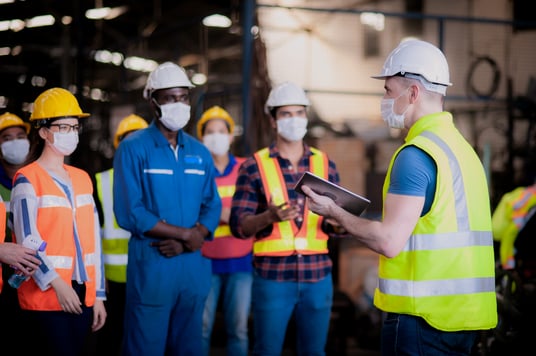In today’s competitive business landscape, a focus on employee well-being isn’t simply a feel-good initiative; it’s a strategic imperative.
A happy, healthy, and safe workforce is not only ethically responsible but also translates to a more productive, successful, and profitable organization. Unfortunately, workplace accidents remain a persistent threat, causing not only physical and emotional harm to employees but also significant financial burdens for companies. These burdens come in the form of increased healthcare costs, lost productivity due to injuries and downtime, potential legal ramifications, and a damaged company reputation.
The good news is that a significant portion of these accidents are preventable. By implementing proactive injury prevention strategies, you can significantly reduce the risk of accidents in your workplace and foster a culture of safety that prioritizes the well-being of your most valuable asset – your employees.
This article explores a comprehensive range of proactive measures you can take to create a safer and healthier work environment for everyone. From cultivating a safety-first mindset to promoting employee wellness, these strategies will equip you to minimize the risk of accidents and create a work environment where everyone feels empowered to prioritize their safety. By investing in proactive prevention, you’ll not only safeguard your employees but also reap the numerous benefits associated with a strong safety culture.
Cultivate a Culture of Safety
It all starts with fostering a safety-first mindset within your organization. Here’s how to achieve this:
- Leadership Commitment: Senior leadership plays a crucial role in setting the tone for safety. Regularly communicate the importance of safety, actively participate in safety initiatives, and recognize employees who demonstrate safe work practices.
- Open Communication: Encourage employees to report unsafe conditions, practices, or near misses without fear of reprisal. Establish anonymous reporting systems or hold regular safety meetings where employees feel comfortable raising concerns.
- Employee Involvement: Involve employees in safety committees or task forces. This not only leverages their knowledge of specific work areas but also fosters a sense of ownership and accountability for safety.
Comprehensive Safety Training
Don’t rely on a one-time safety orientation during onboarding. Here’s how to create effective training:
- Needs Assessment: Conduct a workplace hazard assessment to identify the specific risks and hazards relevant to your industry and daily operations.
- Tailored Training: Develop training programs that address the identified hazards and are specific to different job roles and departments. For example, training for construction workers will differ from training for office staff.
- Interactive Learning: Go beyond traditional lectures. Incorporate interactive elements like demonstrations, case studies, hands-on practice sessions, and quizzes to keep employees engaged and enhance knowledge retention.
Hazard Identification and Risk Assessment
Proactive safety requires a proactive approach to identifying potential hazards. Here’s how to implement this:
- Regular Inspections: Conduct regular inspections of your workplace, paying close attention to areas with high traffic, machinery use, or potential for slips, trips, and falls. Include storage areas, electrical wiring, and emergency exits in your inspections.
- Employee Involvement: Involve employees in the inspection process, as they may be aware of specific hazards in their daily routines that management might miss.
- Risk Assessment: Once hazards are identified, assess the severity of the potential injury and the likelihood of the hazard occurring. This will help you prioritize control measures.
Ergonomic Considerations
Many workplace injuries are caused by repetitive motions, awkward postures, or improper lifting techniques. Here’s how to incorporate ergonomics:
- Workstation Design: Evaluate workstations to ensure proper posture, adequate legroom, and easy reach to necessary tools and equipment. Consider providing adjustable chairs and workstations to accommodate different body types.
- Lifting Techniques: Train employees on proper lifting techniques, emphasizing the importance of using proper body mechanics and utilizing lifting aids when necessary.
- Job Rotation: If possible, implement job rotation schedules to reduce the risk of repetitive strain injuries associated with prolonged performance of the same tasks.
Regular Maintenance
Faulty equipment and machinery are major contributors to workplace accidents. Here’s how to ensure proper maintenance:
- Maintenance Schedule: Develop a comprehensive maintenance schedule for all equipment and machinery, outlining regular inspection intervals and necessary maintenance procedures.
- Qualified Personnel: Ensure that maintenance is performed by qualified personnel who can identify potential problems and address them promptly.
- Employee Reporting: Encourage employees to report any malfunctions or equipment damage immediately, so that repairs can be made before an accident occurs.
Incident Reporting and Investigation
Encourage employees to report all incidents, near misses, and safety concerns, no matter how minor they may seem. Here’s how to create a reporting system:
- Easy Reporting: Make it easy for employees to report incidents. This could involve establishing an anonymous online reporting system, providing reporting forms readily available throughout the workplace, or offering multiple reporting channels like email or a safety hotline.
- Prompt Investigation: Promptly investigate all reported incidents, regardless of severity. This demonstrates your commitment to safety and helps identify root causes to prevent future occurrences.
- Corrective Action: Based on the investigation findings, implement corrective actions to address the root causes of the incident and prevent similar events from happening again.
Employee Wellness Programs
A healthy and well-rested workforce is less susceptible to injuries. Here’s how to promote employee well-being:
- Healthy Lifestyle Programs: Offer programs or resources that encourage employees to adopt healthy habits. This could include on-site fitness classes, healthy cooking demonstrations, or wellness challenges that promote physical activity and healthy eating.
- Stress Management Techniques: Work-related stress can contribute to fatigue and decreased focus, which can increase the risk of accidents. Provide workshops or training on stress management techniques such as mindfulness practices, relaxation exercises, or time management skills.
- Fatigue Awareness: Educate employees about the dangers of fatigue and the importance of getting enough sleep. Encourage them to take breaks throughout the day, and consider implementing flexible work arrangements to help them achieve a healthy work-life balance.
- Employee Assistance Programs (EAPs): Offer access to Employee Assistance Programs (EAPs) that provide confidential counseling and support services for employees dealing with personal or mental health challenges.

Investing in a Culture of Safety
Injury prevention goes beyond implementing isolated programs. It’s about fostering a culture of safety that permeates every aspect of your organization. This culture thrives on continuous improvement, open communication, and a shared commitment to employee well-being. By prioritizing safety and taking a proactive approach, you reap significant benefits:
- Reduced Accident Rates: Fewer accidents translate to lower healthcare costs, less workplace disruption, and a safer work environment for everyone.
- Improved Employee Morale: Employees who feel valued and safe are more likely to be engaged, productive, and loyal to their company.
- Enhanced Company Reputation: A strong safety record demonstrates your commitment to social responsibility and can attract and retain top talent.
- Reduced Worker’s Compensation Claims: Fewer accidents lead to fewer worker’s compensation claims, which can significantly impact your bottom line.
.jpeg?width=563&height=317&name=AdobeStock_496405276%20(1).jpeg)
Building a culture of safety is an ongoing journey, but the rewards are substantial. By consistently evaluating your safety programs, soliciting employee feedback, and adapting your strategies based on current trends and best practices, you can create a workplace where safety is not just a priority, but a deeply ingrained value shared by everyone. Remember, a safe workplace is not just good for business; it’s the right thing to do for your employees. Make safety a core value, invest in proactive prevention strategies, and empower your workforce to prioritize their well-being. By doing so, you can cultivate a thriving work environment where everyone feels valued, respected, and safe.

